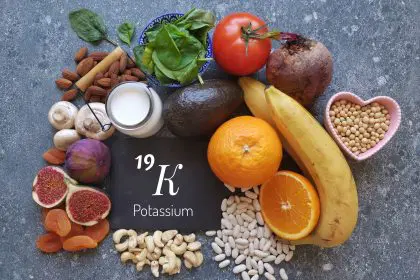Everything you need to know about these essential minerals that support bone strength, muscle function, and overall wellness
The hidden heroes in your body’s daily operations
Magnesium and phosphorus might not make headlines like calcium or iron, but these unsung heroes perform countless vital functions throughout your body every day. These minerals work tirelessly behind the scenes, powering everything from your heartbeat to your bone structure. Since your body cannot produce either mineral on its own, obtaining adequate amounts through diet or supplements remains essential for optimal health.
Most people recognize calcium as the star player in bone health, but magnesium and phosphorus deserve equal billing. Together, this mineral trio forms the structural foundation of your skeleton. Phosphorus pairs with calcium to create hydroxyapatite, the primary component of bone tissue, while magnesium regulates how calcium is used within the bones. Without sufficient levels of all three minerals, bone strength and integrity suffer significantly.
Beyond their structural roles, these minerals function as cellular energy regulators. Phosphorus forms the backbone of ATP (adenosine triphosphate), the primary energy currency used by every cell in your body. Magnesium activates the enzymes that allow ATP to release its stored energy, essentially serving as the ignition key that starts your cellular engines. This energy production powers everything from your heartbeat to your thoughts.
The nervous system relies heavily on both minerals to transmit signals throughout the body. Magnesium regulates calcium flow into nerve cells, controlling the timing and intensity of nerve signals. Meanwhile, phosphorus helps form the myelin sheath that insulates nerve fibers, allowing for efficient signal transmission. Together, they ensure your nervous system communicates properly, affecting everything from muscle movement to mood regulation.
The bone-building duo your skeleton craves
Your skeleton undergoes constant renovation throughout life, with specialized cells breaking down old bone tissue while others build new bone in a process called remodeling. Magnesium and phosphorus play essential roles in this continuous renovation project. They stimulate the activity of osteoblasts (bone-building cells) while helping regulate osteoclasts (cells that break down bone), maintaining the delicate balance needed for strong, healthy bones.
Magnesium influences how vitamin D functions in your body, which directly impacts calcium absorption and bone mineralization. Without adequate magnesium, vitamin D cannot convert to its active form, potentially leaving your bones vulnerable despite adequate calcium intake. This interconnected relationship makes magnesium particularly important for preventing conditions like osteoporosis, especially in older adults.
Phosphorus contributes approximately 50% of bone mineral content, second only to calcium. This mineral combines with calcium to form hydroxyapatite crystals that give bones their strength and rigidity. The proper ratio between calcium and phosphorus proves critical—too much phosphorus relative to calcium can actually weaken bones by triggering calcium release from bone tissue into the bloodstream.
During childhood and adolescence, these minerals become particularly crucial as bones grow rapidly and acquire peak density. Children and teenagers require proportionally higher amounts of both minerals to support healthy bone development. This foundation established during youth significantly influences bone health throughout adulthood and into senior years.
Muscle movement and nerve communication enhancers
Every muscle contraction in your body depends on a carefully orchestrated mineral dance, with magnesium playing a leading role. This mineral regulates calcium entry into muscle cells, facilitating the contraction process while also enabling muscles to relax afterward. Without sufficient magnesium, muscles may contract excessively or fail to relax properly, potentially leading to cramping, spasms, and persistent tension.
Approximately 30% of the magnesium in your body resides within muscle tissue, highlighting its importance for movement. Athletes and physically active individuals may require higher magnesium intake to support increased muscle demands. The relationship between magnesium and exercise works both ways—physical activity helps maintain healthy magnesium levels, while adequate magnesium supports optimal exercise performance.
Phosphorus contributes to muscle function through its role in energy production and protein synthesis. Muscle contractions require immediate energy access, which phosphorus provides through its central role in ATP. Additionally, phosphorus participates in the creation of phosphocreatine, a compound that supplies rapid energy during intense muscle exertion, such as weightlifting or sprinting.
The nervous system relies on precise mineral balance to transmit signals effectively. Magnesium regulates glutamate, the primary excitatory neurotransmitter in the brain, while also supporting GABA, the main inhibitory neurotransmitter. This dual action helps maintain balanced brain activity. Phosphorus contributes to neurological health through its role in forming phospholipids, essential components of cell membranes in brain and nerve tissue.
Health risks when these minerals fall out of balance
Maintaining appropriate levels of both minerals proves crucial for overall health. When imbalances occur, various systems throughout the body may suffer. Low magnesium levels, a condition called hypomagnesemia, can decrease bone density significantly, increasing fracture risk and potentially weakening teeth and gums. Beyond skeletal effects, insufficient magnesium may lead to elevated blood pressure, insulin resistance, and increased inflammation—all risk factors for cardiovascular disease.
Conversely, excessive magnesium typically occurs only with supplement overuse or in people with kidney dysfunction. High levels can cause digestive distress, including nausea, abdominal cramping, and diarrhea. In severe cases, magnesium toxicity may lead to irregular heartbeat, extremely low blood pressure, confusion, and potentially fatal cardiac complications—though this rarely occurs from dietary sources alone.
Phosphorus deficiency, while uncommon in developed countries, can result in serious bone conditions. Adults may develop osteomalacia, characterized by soft, painful bones, while children might develop rickets, causing bone deformities and impaired growth. Other symptoms include muscle weakness, breathing difficulties, and altered mental status in severe cases.
Excess phosphorus presents its own challenges, particularly for individuals with kidney disease who cannot efficiently remove surplus amounts. Too much phosphorus can inhibit bone healing processes and contribute to cardiovascular calcification, where calcium-phosphate deposits form in blood vessels and heart tissue. Over time, this calcification increases heart disease risk significantly.
Food sources to boost your intake naturally
Incorporating magnesium-rich foods into your diet provides the most natural and safe way to maintain healthy levels. Dark leafy greens like spinach and kale offer abundant magnesium, with one cup of cooked spinach providing approximately 157 milligrams. Nuts and seeds rank among the richest sources, with pumpkin seeds containing about 156 milligrams per ounce and almonds providing 80 milligrams per ounce.
Legumes deliver excellent magnesium content along with protein and fiber. One cup of black beans contains roughly 120 milligrams, while the same amount of chickpeas provides about 80 milligrams. Whole grains such as brown rice, quinoa, and whole wheat bread offer significant magnesium content, with one cup of cooked brown rice providing approximately 86 milligrams.
Phosphorus appears abundantly in protein-rich foods from both animal and plant sources. Dairy products rank among the richest sources, with one cup of milk containing about 250 milligrams and the same amount of yogurt providing roughly 300 milligrams. Meat and fish deliver substantial amounts, with 3 ounces of chicken containing approximately 200 milligrams and the same amount of salmon providing about 250 milligrams.
Plant-based phosphorus sources include most legumes, with one cup of lentils containing approximately 350 milligrams. Nuts and seeds also provide significant amounts, with one ounce of pumpkin seeds offering about 330 milligrams. Some foods contain phosphorus additives, particularly processed foods and soft drinks, though this form may be less beneficial than naturally occurring phosphorus.
Supplement considerations and dosage guidelines
While obtaining nutrients from food sources generally provides the safest approach, some individuals may benefit from supplementation based on specific health conditions or dietary restrictions. Common conditions associated with low magnesium include alcohol use disorder, gastrointestinal disorders like Crohn’s disease and celiac disease, type 2 diabetes, and certain medication uses, particularly long-term diuretic therapy.
The Recommended Dietary Allowance (RDA) for magnesium varies by age and sex. Adult men require 400-420 milligrams daily, while adult women need 310-320 milligrams. Pregnant women have slightly higher requirements at 350-360 milligrams daily. Magnesium supplements come in various forms, with magnesium citrate and magnesium glycinate typically offering better absorption and less digestive discomfort than magnesium oxide.
Phosphorus supplements rarely become necessary for healthy individuals since the mineral appears abundantly in many common foods. The RDA for phosphorus stands at 700 milligrams daily for all adults. Certain medical conditions might require phosphorus supplementation, including alcoholism, malnutrition, and certain rare genetic disorders affecting phosphorus metabolism.
When considering supplementation, timing matters. Magnesium supplements often work best when taken with food to minimize digestive discomfort. Many people find taking magnesium in the evening beneficial, as it may promote relaxation and better sleep. Phosphorus supplements, if prescribed, should be taken according to healthcare provider recommendations, as they may interact with other minerals or medications.
Medication interactions to watch for
Before beginning any mineral supplementation regimen, consulting healthcare providers remains essential, particularly for individuals taking medications that might interact with these minerals. Several medication classes warrant special consideration when taken alongside magnesium or phosphorus supplements.
Bisphosphonates, medications prescribed for osteoporosis treatment, should not be taken alongside magnesium supplements. The mineral can significantly reduce the absorption of these medications, potentially rendering them less effective. Generally, separation by at least two hours provides sufficient time to avoid interaction.
Certain antibiotics, particularly tetracyclines and fluoroquinolones, form complexes with magnesium that prevent proper absorption. These antibiotics should be taken at least two hours before or four to six hours after magnesium supplements to maintain therapeutic effectiveness. Similar considerations apply to phosphorus supplements, which can also bind with certain antibiotics.
Various heart and blood pressure medications interact with these minerals. Some diuretics, particularly loop diuretics, can increase magnesium excretion, potentially leading to deficiency over time. Conversely, potassium-sparing diuretics may reduce magnesium excretion, potentially leading to elevated levels if supplements are also taken.
Individuals taking medications for acid reflux or heartburn should exercise caution with both minerals. Magnesium-containing antacids can interact with numerous medications by altering stomach pH or binding directly with drugs. Similarly, some acid reducers may alter the absorption of phosphorus from both food and supplement sources.
Recognizing deficiency symptoms
Identifying potential mineral deficiencies early allows for prompt intervention before more serious complications develop. Magnesium deficiency often manifests initially through subtle signs that many might attribute to stress or other causes. Early symptoms include muscle twitches, cramps, fatigue, and generalized weakness. Many people first notice leg cramps at night or eye twitches that persist without clear cause.
As magnesium deficiency progresses, more significant symptoms may emerge. These include irregular heartbeat or palpitations, numbness or tingling sensations, personality changes, and in severe cases, seizures. Mental health changes often accompany deficiency, with increased anxiety, irritability, and poor concentration commonly reported.
Phosphorus deficiency symptoms typically develop more gradually unless caused by a medical emergency. Early signs include muscle weakness, bone pain, and increased susceptibility to infections. Changes in appetite, breathing difficulties, and joint stiffness may follow as deficiency continues. Children with phosphorus deficiency may show delayed growth and dental development.
Certain populations face higher deficiency risks for both minerals. Older adults often experience reduced absorption capacity along with increased medication use that may deplete these minerals. People with digestive disorders, particularly those affecting the small intestine where most mineral absorption occurs, frequently develop deficiencies despite adequate dietary intake. Those with kidney disease, diabetes, or alcohol dependence also face significantly elevated risk.
By understanding the critical roles these minerals play and recognizing potential deficiency signs, you can take proactive steps to maintain optimal levels. Whether through dietary adjustments or appropriate supplementation under medical guidance, ensuring adequate magnesium and phosphorus intake represents a fundamental aspect of supporting your overall health.

















